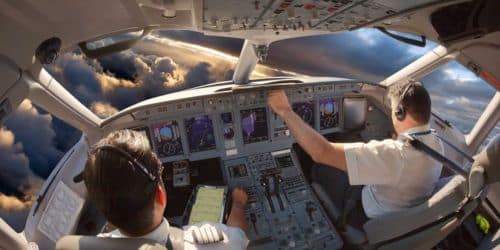To operate an airplane, helicopter, or any other form of aircraft safely and efficiently, firms and individuals need professional pilots. A pilot’s education and experience requirements are similar across industries and aircraft types. The Salary for a pilot varies widely depending on criteria including the size of the organization hiring them, their level and seniority within the company, the number of hours they work each month, and their location. This article explains how to become a pilot and gives accurate information about the salary of an international and commercial pilot. Let’s dive in!
What Do Pilots Do?
Pilots operate and fly a wide variety of aircraft for a variety of purposes, including but not limited to passenger and cargo transportation, search and rescue, aerial photography, and more. Commercial pilots can work for a number of different organizations, but airline pilots are only engaged by one and are limited to flying passengers and cargo on predetermined routes. All pilots, regardless of specialty, are ultimately responsible for the aircraft’s safe operation and the following tasks:
- Choosing the most direct and cost-effective flying path
- Conducting pre- and post-flight checks on aircraft.
- Maintaining regular contact with the appropriate groups and individuals
- Keeping detailed logs of aircraft flights
- Keeping the passengers and cabin crew as safe and comfortable as possible during the flight.
- Checking the plane’s structural soundness
Both the military and flight schools that have received approval from the Federal Aviation Administration (FAA) are options for those who want to pursue a career as a pilot. To earn their pilot’s license, candidates must demonstrate their competence in a variety of areas, including theory, physiology, and practical flying. It’s a good idea to learn about the specific qualification and licensing standards for each type of pilot before applying.
How to Become a Pilot
The following are the steps you need to take to become a pilot:
#1. Do Your Research
There are several routes to becoming a pilot, so it’s important to do research before choosing one. Do some research on the many pilot schools in your area to see whether one of them is a good fit for you, or if you should pursue some other career path, such as joining the military. It’s a good idea to learn as much as possible about the plane and the route you want to fly before you take off.
Include an exploration flight in your preferred aircraft while you are conducting your study. In order to help prospective students make an informed choice, several flight schools provide a “discovery flight” before formal enrollment. Those who aren’t quite ready to enroll in pilot training can experience what it’s like to fly a private plane by chartering a flight.
#2. Choose a Career Path
After looking at several aircraft and flight schools, you should decide on a career route. Common job descriptions include:
#1. Aviation School
The two categories of aviation educational institutions are known as “part 141” and “part 61” schools. The FAA has given permission for Part 141 schools to deliver quick, exacting, and thorough training. Academies and vocational schools that are part of Part 61 typically have a smaller student body and a stronger focus on careers.
#2. Military
The military offers training for those interested in becoming pilots. It’s a frequent route taken by those who aspire to be others’ pilots. This route requires a bachelor’s degree and commissioning in the military before you can start training as a pilot. Joining the military could be a great way to save money on college by enrolling in a program that pays for your bachelor’s degree if you become an officer.
#3. Aviation Training Programs
Airlines developed these initiatives in response to a critical shortage of pilots. Some jobs only require a high school diploma or GED, while others specify that applicants have to be able to legally work in the United States, have a clean criminal record check, and have excellent written and verbal communication skills.
#3. Apply for Your FAA Credentials
Once a career route has been decided, it is time to begin working toward the necessary licenses and clearance from the Federal Aviation Administration (FAA). This is the primary need for getting into the piloting profession. You’ll need to get a medical certificate from the FAA and show proof that you’re in good enough health to fly. Some of these include being able to see clearly at 20 feet, with or without corrective lenses, distinguishing between specific colors used in aviation, and passing a drug test.
If you intend to pilot a powered aircraft on your own, you should apply for a student pilot certificate as soon as you begin your flight training. Although this license is not required to begin taking flying lessons, it will be required before you are allowed to fly independently as a student pilot. Your flight instructor should be able to answer any questions you may have about the FAA’s registration procedure.
#4. Accumulate Flight Time and Experience
A minimum of 40 hours of flight experience is required to earn a private pilot certificate. An instructor-led flight training program of 20 hours and 10 hours of solo flight time is required for this level of flight expertise. If you want to grow in your profession as a pilot, you need to keep accumulating hours, as a private pilot certificate does not allow you to accept any form of compensation.
#5. Prove Your Competence by Acing the Theory and Practice Tests
Before you can earn your FAA license, you’ll need to demonstrate your competence in both written and practical tests. If you decide to further your career as a pilot, you can apply for a commercial pilot license once you have the necessary experience and training. You can start applying for jobs now that you have this certification.
What Is the Pilot Salary?
Pilot salary, like that of other occupations, varies widely. There are annual differences in pilot salary between airlines, types of aircraft, and even flying routes. Pilot qualifications, years of experience, job titles, and pilot union agreements are only some of the variables that affect the salary of a pilot. Most individuals also have no idea that pilots are paid on an hourly basis rather than a set wage. However, salary is different among airlines.
The average salary for a pilot at Southwest Airlines is $222,000. On the other hand, some Southwest pilots make up to $549,000. The average salary for a United Airlines pilot is $205,000. The average pilot salary at Delta Airlines is $192,000, with the highest salaries reaching $526,000 per year. Also, the average annual income for pilots at American Airlines is $118,000; some make more than $700,000. Salary growth for pilots is a major positive trend. Even foreign airlines offer generous wages. For instance, the average salary for pilots in Qatar is $173–187,000. Furthermore, pilots for China Southern Airlines begin earning an annual salary of $228,000. A Lufthansa pilot’s annual salary is around $102,000.
International Pilot
Many pilots are drawn to the allure of international travel. There’s something really alluring about the idea of getting paid to travel the world and learn about other cultures. There are a few reasons why pilots aspire to fly internationally. The first justification is monetary. Pilots who fly internationally make more money than those who fly domestically. This is due to the fact that traveling abroad is typically more complicated and requires more skill. The second factor is the way of living. Pilots who fly internationally frequently have greater freedom with their schedules and more opportunities for exciting layovers.
And finally, there’s the third reason: exposure. Traveling to new countries and learning about other cultures is really educational. It’s an excellent method of expanding one’s knowledge of the world and its inhabitants. There is a wide range of factors that attract pilots to foreign routes. A career as a pilot offers several advantages, including higher money, greater freedom, and the chance to travel to exotic locations.
International Pilot Salary
In the United States, the average yearly salary of an international pilot is between $41,000 (25th percentile) and $90,000 (75th percentile), with the best earners (90th percentile) making $130,000 a year.
In the US, an international pilot can earn an annual income between $75,210 and $107,385. The states of Alaska, California, the District of Columbia, New Jersey, and Massachusetts all pay more than the national average for international pilot positions. If you use the filter, you may narrow down your employment search to only those opportunities that are relevant to your interests as an International Pilot. Students applying to this airline pilot program (foreign students) must already be well-versed in the basics of flying commercial aircraft. The average international pilot salary in the US is $116,834, while the average international pilot salary in the lowest bracket is $81,828.
What Is a Commercial Pilot?
A person who holds a commercial pilot license is considered to be an aviation professional. Commercial pilots have a wide range of employment options depending on their class rating. Pilots’ class ratings determine the types of aircraft they are qualified to fly, such as whether they can land on land or water and the number of engines each plane can have. Pilots require additional certification as airline transport pilots in order to fly for a commercial airline.
For the purpose of flying commercial aircraft, commercial pilots must satisfy stringent educational and training standards. U.S. Federal Aviation Administration rules frequently apply to them.
Commercial Pilot Salary
Pilots on commercial airlines often get paid on an hourly basis based on the number of hours they spend in the air. However, pilots typically receive a base salary plus overtime and extra money for their efforts. Average annual salaries for airline pilots, co-pilots, and flight engineers are $202,180, according to the BLS.
What Are the Benefits of Working as a Commercial Pilot?
The following benefits are also enjoyed by commercial pilots who work for airlines and regularly scheduled carriers:
- Advantages of Flying: The vast majority of airlines allow their staff to fly for free when there are tickets available.
- Time constraints: For safety, the FAA limits the number of hours a pilot can work per year, granting commercial airline pilots significant time off.
- Compensation: Commercial airline pilots often receive a base salary, plus overtime and bonuses based on the number of hours they spend in the air.
- Freelancing: Pilots who have experience flying for commercial airlines are also qualified to fly private aircraft, opening them to the option of freelancing.
What Actions May a Pilot Do to Increase Their Earnings?
If you want to make more money as a pilot, you should focus on these strategies.
#1. Find a Job with a Major Airline
Compared to other pilot specializations like rescue pilots, tourist pilots, and others, airline pilots often earn the most money. Pilots working for national and international airlines make significantly more than their counterparts at regional carriers. A good track record as a local airline pilot can increase your chances of being hired by a large airline or cargo carrier, where most pilots begin their careers.
#2. Advance in Rank
Pilot salaries are heavily influenced by a pilot’s seniority within a corporation. In order to qualify for an entry-level pilot position at a regional airline, prospective pilots must first complete initial flight training and log 1,500 flight hours to receive an Airline Transport Pilot (ATP) certificate. The more time, effort, and money you put into increasing your pilot credentials, the higher your earning potential will be.
#3. Move to a Higher-Paying State for Work
A pilot’s salary can differ from state to state, even if they have the same amount of experience and work for an airline of the same size. A pilot in Atlanta, Georgia, can expect a starting salary of $122,201 per year. This is in contrast to the average base salary of $59,951 that pilots in Chicago, Illinois receive.
Why Does Pilot Salary Range Matter?
It’s important to keep in mind that the lowest and highest pilot salary points are just two ends of a continuum. Depending on your level of airline pilot experience, this can vary slightly. Both passenger and cargo airlines must follow this rule. A First Officer at FedEx Express makes $84 an hour on the low end, while a Captain makes $335 an hour on the high end. At UPS, the range is much wider, from $50 an hour for entry-level First Officers to $338 an hour for senior Captains. These are actual compensation calculations from several freight carriers and cover a wide range.
What Is the Starting Salary for a Pilot?
Commercial pilots commonly begin their careers as flight teachers to accrue flight time after completing their first flight training. In order to become a first officer (second-in-command) and receive an air transport pilot (ATP) license from the FAA, a pilot must log 1,500 flying hours. One can earn a living while helping others achieve their dreams of becoming pilots by becoming a licensed flight teacher and logging flight hours. A flight instructor makes an average yearly pay of $66,338.
How Long Can You Sustain a Pilot’s License?
There is a mandatory retirement age of 65 set by the FAA for all airline pilots. After leaving the commercial airline industry, there are still plenty of chances to fly for private clients. A pilot’s health is also crucial to their career duration since they must be in good standing with regular checkups. If the pilot’s physical examination goes well, he or she will retain the Class 1 medical certificate necessary to fly for a commercial airline. Tests must be taken annually by pilots under the age of 40 and every six months by those above the age of 60.
What Factors into How Much Money Pilots Make?
pilots are compensated for their time in the air. Pilots are only allowed to log a maximum of 1,000 flight hours per year to protect their health and well-being and keep them from burning out. Due to this restriction on available working time, the hourly rate is the primary consideration in determining a pilot’s total compensation. The amount a pilot is paid per hour varies from airline to airline and may also vary depending on the type of aircraft they fly and their level of experience.
Can You Increase Your Salary as a Pilot through Networking?
Pilots can benefit from networking in the same way that it benefits other professionals. While a pilot’s experience and education level are the most significant criteria in determining pay, the connections you create through your work can help you advance to higher-paying positions later in your career. You can expand your professional and personal network by joining a professional pilot organization or attending a social networking event.
How Have Pilot Salaries Changed Recently?
The BLS reports that in 2021, the median annual salary for airline pilots, copilots, and flight engineers was $202,180. There is expected to be a 14% increase in demand for airline pilots, copilots, and flight engineers between the years 2020 and 2030. The projected growth rate for pilots and other forms of flight engineers is 13%. Employment prospects for commercial pilots are 11% higher than average.
Final Thoughts
U.S. pilots earn about the same as their counterparts abroad. Many foreign airlines are on the lookout for American pilots, and some of them are willing to provide substantial relocation bonuses on top of annual salaries to attract them. The salary a pilot also receives from a global corporation may vary depending on their certification, level of experience, and licensing requirements.
Related Articles
- AIRLINE PILOT REQUIREMENTS: Complete Guide on How to Become One
- HOW TO BECOME AN AIRLINE PILOT: US Career Practices (Steps & Requirements)
- BEST DAY TO BUY AIRLINE TICKETS: Do Prices Go Down on Tuesday
- WHAT DAY ARE FLIGHTS CHEAPEST TO BOOK? All You Need To Know.
- UNITED AIRLINES LOGO: Meaning, History, and Why the Logo Was Changed






